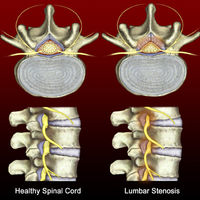Spinal Stenosis
The spine is made up of 33 bones. These and the discs between them provide a passage for the spinal cord and nerves. The spinal cord itself connects the nerves of the body to the brain.
Spinal stenosis is a narrowing of the passage where the spinal cord runs.
Stenosis can affect any part of the spine, although it rarely affects the upper back. When the narrowed area is in the bones of the neck, it is called cervical stenosis. When the narrowed area is in the bones of the lower back, it is called lumbar stenosis.
Symptoms
The pressure on nerves inside the narrowed spinal canal can cause pain in the legs when walking.
In the illustration of cervical stenosis, the narrowing is caused by bone spurs growing into the spinal canal. This puts pressure on the spinal nerves and the spinal canal.
In the illustration of lumbar stenosis, the narrowing is caused by thickening of the spinal ligaments.
Causes and Risk Factors
This condition can develop because of:
Genetics
Development problems in the spine before birth
Poor posture and body mechanics
Degenerative disc disease
Obesity
Age
Diseases such as arthritis, scoliosis, osteoporosis and lordosis (sway back)
Diagnosis
To diagnose spinal stenosis, a medical history is taken and physical exam is performed. Patients are asked for a detailed description of their pain and about limitations on movement, pain and a loss of reflexes, which may be evidence of nerve involvement.
Other procedures that can help confirm the diagnosis include:
X-rays, which can help rule out tumors, injuries or other abnormalities
Magnetic resonance imaging (MRI), which can help detect damage or disease in the soft tissues such as the discs or ligaments.
Computed tomography (CT) scan, which can show the shape, size and nearby structures of the spinal canal.
Myelogram, in which an opaque dye is injected into the spinal column followed by an X-ray. This can show pressure on the spinal cord or nerves from herniated discs, bone spurs or tumors.
Bone scan, which can detect fractures, tumors, infections and arthritis
Treatments
Knowing the cause is the key to prevention. Practicing good spinal and joint health can help reduce the chance of this condition, even for those with an inherited risk of developing the condition.
Treatment options include:
Foraminotomy, removal of bone and soft tissues to enlarge a passage for the nerve
Surgical decompression, a procedure to free space for the nerves in the spinal canal. A number of different surgical methods are commonly used to achieve decompression, including laminectomy, laminotomy, laminoplasty, foramenotomy and anterior discectomy.
The ideal technique to use depends on where the narrowing is located, what is causing the narrowing, how stable the spine is and the surgeons expertise.

Related Articles / Documents